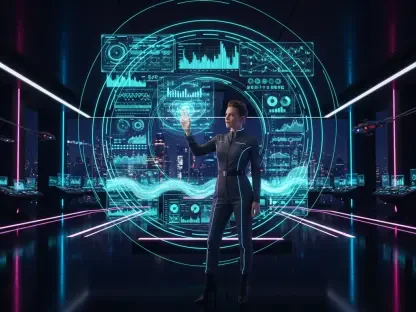In today’s rapidly evolving landscape of work, the integration of AI technologies is reshaping how businesses approach talent management and organizational structure. Marco Gaietti, a seasoned expert in business management, shares invaluable insights into the future of work, particularly as machine-human workforces become more prevalent. With his decades of experience, Marco offers a compelling perspective on the challenges and opportunities presented by agentic AI systems in HR.
Could you explain the concept of the machine-human workforce as mentioned in the article?
The machine-human workforce represents a transformative shift in how we perceive roles within an organization. It’s about blending human and AI capabilities into a cohesive unit that actively collaborates and co-creates. This concept moves beyond the traditional view of automation challenging human roles, instead embracing AI as part of the team. We’re entering an era where AI agents aren’t just tools but are integral, proactive participants in decision-making and creative processes.
What roles do AI agents play in the HR recruitment process according to the article?
AI agents are now critical components of the recruitment process, taking on tasks that traditional systems couldn’t handle with the same efficiency or insight. These agents schedule interviews, craft structured questions, analyze feedback, and even recommend candidate progression. They go beyond executing commands, offering evidence-based suggestions drawn from past patterns, thus streamlining recruitment and enhancing decision-making.
How does agentic AI differ from traditional AI and automation technologies?
Agentic AI distinguishes itself by being more autonomous and context-aware compared to traditional AI. While conventional automation follows preset rules to perform specific tasks, agentic AI learns and adapts from ongoing interactions within the workplace. It makes decisions, prioritizes activities, and even executes based on dynamic goals, acting more like a human colleague than a tool.
Can you provide examples of companies that have integrated agentic AI into their HR processes?
Certainly. For example, Oracle has embedded role-based AI agents within its Fusion Cloud HCM platform, covering a spectrum of HR activities from career planning to performance reviews. Workday has launched Illuminate Agents that autonomously navigate recruiting and payroll processes. Lattice offers meeting-participating AI agents that simulate coaching and detect disengagement. These examples highlight the practical uses of agentic AI in daily HR operations.
How are AI agents being used in current HR technology platforms?
AI agents are seamlessly integrated into HR technology platforms as persistent participants in workflows. They actively assist in screening candidates, crafting onboarding experiences, recommending learning paths, and providing real-time managerial guidance. These capabilities are woven into tools like email, dashboards, and collaboration software, making them ubiquitous and vital in modern HR strategies.
What challenges do organizations face when managing a workforce that includes AI agents?
One significant challenge is adapting organizational structures and leadership approaches to manage a mixed team of humans and AI agents. Leaders need to understand the nuances of AI decision-making, develop trust in these systems, and know when to intervene. There’s also a cultural shift required, where employees must see AI agents as partners rather than competitors, ensuring seamless collaboration.
How can managers adapt their skills to effectively manage AI agents alongside human employees?
Managers must embrace a new mindset that includes understanding AI systems and their context-driven actions. They need to cultivate digital fluency to interpret AI outputs and integrate insights effectively into team dynamics. Managers should also be agile, willing to adjust settings or engage with IT teams to refine AI processes. This adaptability is essential for harmonizing human and machine interactions.
What new leadership skills are necessary for managing in an AI-enabled environment?
Leadership in an AI-enabled environment requires more than technical understanding; it demands digital fluency and the ability to interpret AI recommendations. Leaders must build transparent communication with their teams about AI roles and actively engage with system outputs. This includes refining prompts, adjusting parameters, and collaborating closely with technology teams to ensure AI contributions align with organizational goals.
How should leaders provide feedback to AI systems?
Leaders can offer feedback to AI systems by tuning settings, updating parameters, and providing input on system logic. It’s critical to collaborate with IT or data teams to ensure the systems are functioning optimally. Feedback loops should involve refining prompts and incorporating intelligent suggestions into workflows, allowing AI systems to evolve and better serve organizational needs.
What are the key cultural questions that arise with the introduction of intelligent agents into the workplace?
As AI agents become more involved, cultural questions regarding trust and acceptance emerge. Will employees trust and feel comfortable working alongside AI agents? Will these agents be perceived as colleagues or threats? Addressing these concerns involves transparent communication from leaders, showcasing AI as tools for empowerment rather than replacements, thereby fostering a supportive environment.
How do aspects like trust and accountability impact the integration of AI agents?
Trust and accountability are pivotal in AI integration. Establishing trust depends significantly on how organizations communicate AI roles and decisions to their workforce. Accountability challenges arise when determining responsibility for decisions influenced by AI. Ensuring ethical compliance and creating clear boundaries for AI actions are essential steps in mitigating potential risks.
What role does HR have in preparing organizations to work with AI agents?
HR plays a crucial role by modernizing leadership development programs to include AI management skills. HR teams should implement training modules that simulate AI collaboration scenarios, building managers’ confidence and skills in navigating hybrid teams. HR is also responsible for rewriting job descriptions as AI agents take over specific workflows, aligning roles to reflect new responsibilities.
How can leadership development programs be updated to include managing intelligent systems?
Updating leadership development involves incorporating AI collaboration modules, offering managers scenario-based exercises that mimic real-world challenges involving AI. Coaching programs should cover tech-integration skills, such as interpreting AI feedback and augmenting human judgment with AI insights. These initiatives bolster a manager’s ability to lead in a machine-human environment.
What are some practical ways to prepare managers for working with AI agents?
Practical preparation includes providing managers with training sessions that highlight interpreting AI feedback, initiating override protocols, and understanding AI system logic. Simulation-based exercises can help managers navigate scenarios akin to those they’ll experience in the workplace. Early exposure to AI tools within workflows can ease the transition and reinforce their capabilities.
How should organizations rethink team structures and job designs in light of AI integration?
Organizations need to re-evaluate roles and team structures, integrating intelligent systems into their capacity models. Job descriptions may shift as AI handles certain tasks, freeing human resources for higher-value initiatives. This reassessment should reflect intelligent systems in org charts, granting them a defined role within day-to-day operations while keeping humans at the helm.
What steps should HR leaders take to effectively manage a machine-human workforce?
HR leaders should first identify existing AI systems within their organizations and project future deployments. They need to collaborate with IT/data teams to set ownership and guardrails for AI applications. Updating manager training to include AI integration protocols is vital, alongside soliciting employee feedback to spot friction points. Piloting hybrid human-AI teams with clear metrics can refine strategies.
What specific actions can HR leaders take to begin the journey toward managing a hybrid workforce?
HR leaders can start by conducting an AI inventory within the organization to understand current capabilities. Engaging with IT and setting boundaries for AI operations ensures ethical compliance. Updating training to prepare managers for AI interactions and gathering employee feedback to assess comfort levels with AI can highlight areas for improvement. Finally, piloting AI-human teams will provide critical insights into effective hybrid workforce management.
How is AI shaping the future of HR leadership?
AI is transforming HR leadership by shifting focus from managing solely human teams to orchestrating interactions between humans and AI agents. HR leaders now need to guide organizations in adopting digitally fluent practices and integrating AI insights into strategic decisions. This transition marks a turning point in redefining workforce dynamics and optimizing talent management through technology.
What insights might be available at the upcoming HR Tech conference regarding agentic AI?
The HR Tech conference will showcase the latest advancements in agentic AI technology, offering examples of how organizations are weaving these systems into work design. Attendees can expect to learn about best practices for AI integration, leadership skills for managing hybrid teams, and insights into overcoming cultural and operational challenges posed by intelligent systems.
How can organizations ensure ethical and compliant behavior from AI agents?
Organizations must establish robust systems of accountability and control for AI actions. Regular audits, setting clear boundaries for AI scope, and maintaining transparency with employees regarding AI roles are essential measures. Collaborating with legal and IT teams to create guidelines for AI behavior will ensure ethical compliance and safeguard organizational integrity.
Do you have any advice for our readers?
Embrace the change. As machine-human workforces become increasingly normal, it’s crucial to adapt and view AI as collaborators rather than competitors. Build a culture of trust and transparency where AI integration is communicated clearly. Invest in training to enhance digital fluency, ensuring both managers and employees can effectively collaborate with AI systems.









